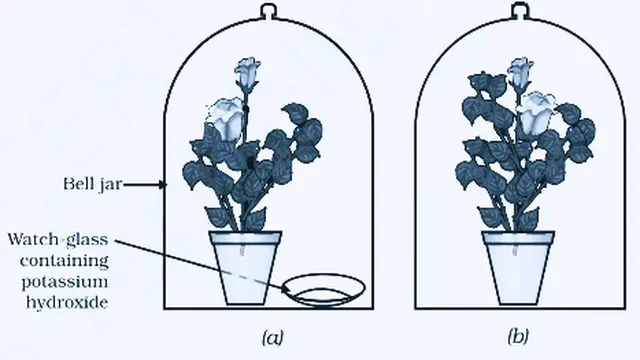In this post, you will find Activity 6.2 Class 10 Science NCERT of NCERT Science book. This NCERT Science Class 10 Chapter 6.2 Activity solution will help you to understand the complete procedure, observations, conclusions, and precautions. You can also go through Activity 6.1 class 10 NCERT Science.
Explain Activity 6.2 Class 10 Science NCERT
After reading Activity 6.2 Class 10 Science NCERT, you can better understand NCERT Science Class 10 Chapter 6.2 Activity solution. Here you will find all NCERT Class 10 Science chapter 6 activities solutions with the complete explanation.
Activity 6.2 Class 10 Science NCERT
Activity - 6.2
Object
– Carbon dioxide is essential for photosynthesis
Materials Required: Two same-sized healthy potted plants, two bell jars, two glass slabs, grease
or vaseline, potassium hydroxide, watch glass, iodine solution, water bath,
alcohol, dropper, forceps, water, beaker, Petri dish, spirit lamp, tripod
stand, wire gauze matchbox, etc.
Procedure
:
(i) Take a potted plant and destarch the plants by
keeping them in a dark room for three days.
(ii) Place each
plant on a separate glass slab or glass plate.
(iii)Take potassium hydroxide in the watch glass and
place this watch glass by the side of one of the plants. Potassium hydroxide
has the ability to absorb carbon dioxide.
(iv) Cover bath the plants with separate bell jars.
See figure.
(v) Use vaseline/grease to seal the bottom of
the jars to the glass plates to make the apparatus airtight.
(vi) Keep the plants in sunlight for 2-6 hours.
(vii) After that pluck a leaf from each plant.
(viii) Perform a test for the presence of starch
in both the leaves separately.
Observation:
The part that was outside and free to absorb carbon dioxide turns blue-black
and the part that was inside the bottle and not getting carbon dioxide does
not turn blue-black. So there starch is not formed or no photosynthesis occurs. The presence of starch can be tested through Iodine Test.
Conclusion: In the leaf of a plant that was kept without potassium hydroxide normal photosynthesis occurred. It got all the materials needed for photosynthesis.
But in the plant with potassium hydroxide photosynthesis did not occur. Because the setup was airtight, carbon dioxide present in the bell jar was absorbed by potassium hydroxide. Therefore, the plant could not make starch in the absence of carbon dioxide.
So this
experiment shows that carbon dioxide is
essential for the process of photosynthesis.
Requirement of carbon dioxide
Atmosphere contains about 0.036% carbon dioxide. All terrestrial (land) plants get it directly from the atmosphere. Carbon dioxide enters the leaves through stomata.
some exchange of gases occurs across the surface of stem, roots, and leaves also. In land plants to minimize the loss of water in the form of water vapour, a plant closes the stomata when carbon dioxide is not required.
The stomata remain open during the daytime. When carbon dioxide is utilized in the process of photosynthesis more of it diffuses from outside. Some amount of carbon dioxide is produced internally in the process of respiration. During the daytime, it is used in the process of photosynthesis.
Carbon dioxide evolved in respiration during night remains
unutilized. The stomata remain closed during the night. Aquatic plants absorb the
carbon dioxide dissolved in water through the
general surface of the aquatic plants.
Iodine test for the starch present in the leaves of green plants
An iodine test
is performed to detect the presence of starch in any substance or compound.
Theory –
When iodine solution is added to starch, it gives a blue-black colour. This test
is known as the iodine-starch test for starch.
Requirement –
alcohol, beaker, spirit lamp, iodine solution, water bath, Petri dishes, and
substance containing starch(green leaves).
Procedure- Take green leaves of plants(money plant) and boil the leaves for 10 minutes in water and then boil the leaves in alcohol. The beaker containing alcohol should be placed in the water bath.
This process makes the leaves completely free of chlorophyll and washes the leaves. Now place the leaves in iodine solution for a few minutes.
Observation- The leaves turn blue-black.
Result-This test shows the presence of starch in the leaves.
So now you can understand activity 6.2 Class 10 Science
NCERT, for better practice you can also search for solutions in chapter 6 Life Processes.
Q1.Which are the important activities to learn in 10th science NCERT textbook Kseeb?
Ans. In 10th Science NCERT textbook Kseeb, you should learn all activities because all chapters are compulsory for the Board examination.
Related Topics –
1. Previous activity –
2. Next activity - Activity 6.3
3. Solution of Chapter 6 Life Processes
4. MCQof chapter 6 Life Processes
5. Extra questions of chapter 6 Life Processes
6. Solutions of Class 10 Science Book

.jpg)



No comments:
Post a Comment